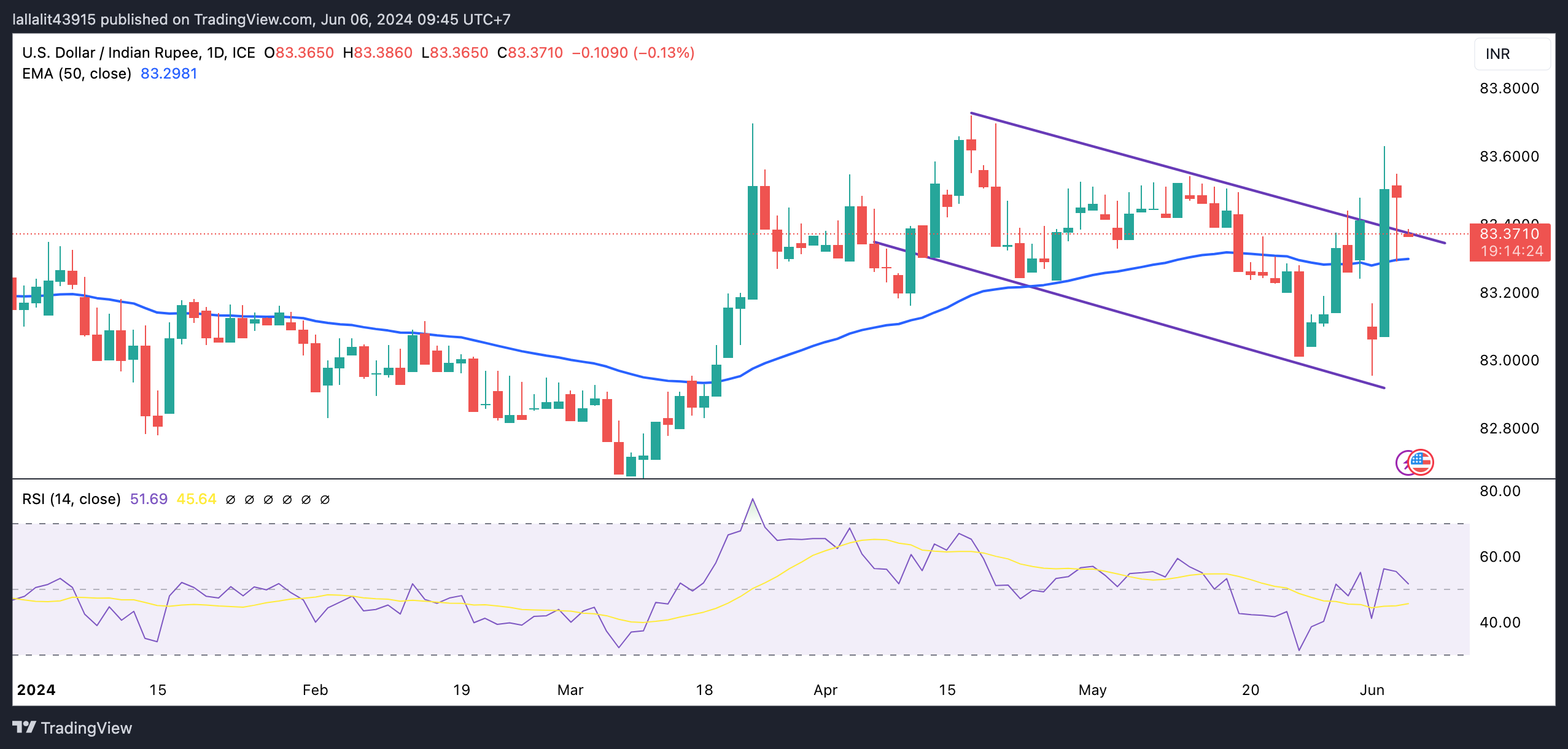- Indian Rupee rebounds on the softer US Dollar on Thursday.
- The renewed USD sales and potential FX intervention from the RBI support the INR.
- Any development surrounding the changes to India’s structural reforms might weigh on the INR.
- The US weekly Initial Jobless Claims and Balance of Trade are due later on Thursday.
Indian Rupee (INR) recovers on Thursday amid the weaker US Dollar (USD). On Wednesday, the INR closed stronger on the back of USD sales from foreign banks and likely intervention from the Reserve Bank of India (RBI). Furthermore, Investors started to price in two interest rate cuts by the Federal Reserve (Fed) this year, which weigh on the Greenback and create a headwind for the pair.
The US weekly Initial Jobless Claims and Balance of Trade are due on Thursday. Investors will closely monitor the RBI's interest rate decision on Friday, with no change in rate expected. Also, the US Nonfarm Payrolls data will be in the spotlight. The stronger-than-expected data could boost the Greenback and cap the downside for USD/INR. Meanwhile, India faces multiple headwinds from the political shifts and downbeat PMI data. If there are changes to India’s structural reforms, this could exert some selling pressure on the Indian Rupee.
Daily Digest Market Movers: Indian Rupee rebounds amid likely RBI intervention
- Overseas investors withdrew $678 million from Indian equities on Wednesday alone, totaling $1.5 billion in two days. According to NSDL, investors sold $1,466.3 million worth of Indian shares on Tuesday, while buying $103.3 million in Indian bonds.
- Benchmark Indian equity indices, the BSE Sensex and Nifty 50 gained on Wednesday, closing the session higher by about 3% each after logging their steepest fall in four years in the previous session.
- The HSBC India Services PMI dropped to 60.4 in May from the final 60.8 in the previous month. This was the 34th consecutive month of expansion in services activity although it registered the lowest mark since December 2023.
- “The election results are likely to keep both the rupee and bond yields volatile in the short run,” HDFC bank economist Sakshi Gupta said.
- Bharatiya Janata Party (BJP) has won 240 seats in the Lok Sabha elections, which was followed by the Indian National Congress winning 99 seats, and the Samajwadi Party winning 37 seats, according to the Election Commission of India’s (ECI) website.
- The US ISM Services PMI improved to 53.8 in May from 49.4 in April. This figure came in stronger than the estimation of 50.8.
- Traders are now pricing in a nearly 70% chance of a Fed rate cut in September, up from 54.9% at the beginning of the week, according to the CME FedWatch tool.
Technical analysis: USD/INR keeps the bullish vibe above the 100-day EMA
The Indian Rupee trades on a stronger note on the day. The positive outlook of the USD/INR pair remains intact as it broke above the descending trend channel that has been established since mid-April and holds above the key 100-day Exponential Moving Average (EMA) on the daily chart. Nonetheless, the 14-day Relative Strength Index (RSI) hovers around the 50-midline, denoting a neutral level and suggesting that further consolidation looks favorable for the time being.
The resistance-turned-support level and the 100-day EMA at the 83.30-83.35 region act as an initial support level for the pair. A decisive break below this level would attract some sellers to the 83.00 psychological level, followed by a low of January 15 at 82.78.
On the other hand, the first upside barrier will emerge near a high of June 4 at 83.62. Further north, the next hurdle is seen near a high of April 17 at 83.72 en route to the 84.00 round mark.
US Dollar price in the last 7 days
The table below shows the percentage change of US Dollar (USD) against listed major currencies in the last 7 days. US Dollar was the weakest against the Swiss Franc.
| USD | EUR | GBP | CAD | AUD | JPY | NZD | CHF | |
| USD | -0.72% | -0.76% | -0.30% | -0.71% | -0.98% | -1.31% | -2.37% | |
| EUR | 0.72% | -0.04% | 0.44% | 0.01% | -0.24% | -0.58% | -1.65% | |
| GBP | 0.76% | 0.04% | 0.47% | 0.04% | -0.23% | -0.54% | -1.62% | |
| CAD | 0.29% | -0.43% | -0.47% | -0.43% | -0.68% | -1.01% | -2.09% | |
| AUD | 0.70% | -0.01% | -0.05% | 0.42% | -0.26% | -0.59% | -1.67% | |
| JPY | 0.97% | 0.26% | 0.20% | 0.66% | 0.27% | -0.33% | -1.40% | |
| NZD | 1.29% | 0.58% | 0.54% | 1.00% | 0.57% | 0.34% | -1.07% | |
| CHF | 2.34% | 1.62% | 1.59% | 2.05% | 1.64% | 1.37% | 1.05% |
The heat map shows percentage changes of major currencies against each other. The base currency is picked from the left column, while the quote currency is picked from the top row. For example, if you pick the Euro from the left column and move along the horizontal line to the Japanese Yen, the percentage change displayed in the box will represent EUR (base)/JPY (quote).
Indian economy FAQs
The Indian economy has averaged a growth rate of 6.13% between 2006 and 2023, which makes it one of the fastest growing in the world. India’s high growth has attracted a lot of foreign investment. This includes Foreign Direct Investment (FDI) into physical projects and Foreign Indirect Investment (FII) by foreign funds into Indian financial markets. The greater the level of investment, the higher the demand for the Rupee (INR). Fluctuations in Dollar-demand from Indian importers also impact INR.
India has to import a great deal of its Oil and gasoline so the price of Oil can have a direct impact on the Rupee. Oil is mostly traded in US Dollars (USD) on international markets so if the price of Oil rises, aggregate demand for USD increases and Indian importers have to sell more Rupees to meet that demand, which is depreciative for the Rupee.
Inflation has a complex effect on the Rupee. Ultimately it indicates an increase in money supply which reduces the Rupee’s overall value. Yet if it rises above the Reserve Bank of India’s (RBI) 4% target, the RBI will raise interest rates to bring it down by reducing credit. Higher interest rates, especially real rates (the difference between interest rates and inflation) strengthen the Rupee. They make India a more profitable place for international investors to park their money. A fall in inflation can be supportive of the Rupee. At the same time lower interest rates can have a depreciatory effect on the Rupee.
India has run a trade deficit for most of its recent history, indicating its imports outweigh its exports. Since the majority of international trade takes place in US Dollars, there are times – due to seasonal demand or order glut – where the high volume of imports leads to significant US Dollar- demand. During these periods the Rupee can weaken as it is heavily sold to meet the demand for Dollars. When markets experience increased volatility, the demand for US Dollars can also shoot up with a similarly negative effect on the Rupee.
Information on these pages contains forward-looking statements that involve risks and uncertainties. Markets and instruments profiled on this page are for informational purposes only and should not in any way come across as a recommendation to buy or sell in these assets. You should do your own thorough research before making any investment decisions. FXStreet does not in any way guarantee that this information is free from mistakes, errors, or material misstatements. It also does not guarantee that this information is of a timely nature. Investing in Open Markets involves a great deal of risk, including the loss of all or a portion of your investment, as well as emotional distress. All risks, losses and costs associated with investing, including total loss of principal, are your responsibility. The views and opinions expressed in this article are those of the authors and do not necessarily reflect the official policy or position of FXStreet nor its advertisers. The author will not be held responsible for information that is found at the end of links posted on this page.
If not otherwise explicitly mentioned in the body of the article, at the time of writing, the author has no position in any stock mentioned in this article and no business relationship with any company mentioned. The author has not received compensation for writing this article, other than from FXStreet.
FXStreet and the author do not provide personalized recommendations. The author makes no representations as to the accuracy, completeness, or suitability of this information. FXStreet and the author will not be liable for any errors, omissions or any losses, injuries or damages arising from this information and its display or use. Errors and omissions excepted.
The author and FXStreet are not registered investment advisors and nothing in this article is intended to be investment advice.
Recommended content
Editors’ Picks

EUR/USD dips below 1.1000 as Trump authorizes 90-day pause on tariffs
EUR/USD retreated below the 1.1000 mark on headlines indicating that United States President Donald Trump authorized a 90-day pause on non-retaliating countries. The pause applies to reciprocal and 10% tariffs, effective immediately, according to a Truth Social post. FOMC Minutes indicated increasing uncertainty.

GBP/USD eases further on tariffs pause announcement, USD still weak
GBP/USD's correction seems to have met a decent contention around the 1.2750 zone so far on Wednesday, as investors continue to assess the ongoing US-China trade war. US doubles the bet, announced 125% levies on Chinese imports.

Gold recedes to $3,050 on Trump's headlines
Gold prices now give away part of their advance and revisit the $3,050 zone per troy ounce after President Trump announced a 90-day pause on reciprocal and 10% tariffs. FOMC Minutes passed unnoticed as optimism returned.

Dow Jones Industrial Average rockets 6% higher on tariff suspension
The Dow Jones Industrial Average (DJIA) skyrocketed on Wednesday, surging over 6% on the day and returning to the 40,000 handle after the Trump administration announced yet another pivot on its own tariff policies.

Tariff rollercoaster continues as China slapped with 104% levies
The reaction in currencies has not been as predictable. The clear winners so far remain the safe-haven Japanese yen and Swiss franc, no surprises there, while the euro has also emerged as a quasi-safe-haven given its high liquid status.

The Best brokers to trade EUR/USD
SPONSORED Discover the top brokers for trading EUR/USD in 2025. Our list features brokers with competitive spreads, fast execution, and powerful platforms. Whether you're a beginner or an expert, find the right partner to navigate the dynamic Forex market.




